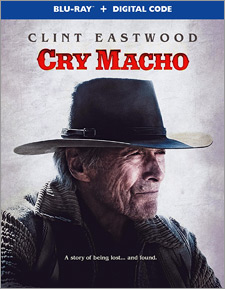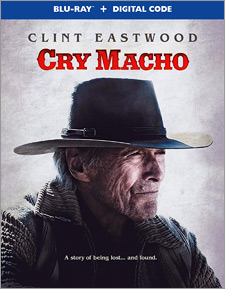Cry Macho (Blu-ray Review)

Director
Clint EastwoodRelease Date(s)
2021 (December 7, 2021)Studio(s)
Malpaso Productions/Warner Bros Pictures (Warner Home Video)- Film/Program Grade: B-
- Video Grade: A
- Audio Grade: B
- Extras Grade: D+
Review
Clint Eastwood has been making movies for eight decades, often acting in and directing the same film. As an actor, he has created such indelible roles as Blondie in The Good, the Bad and the Ugly, Harry Callahan in Dirty Harry, and Bill Munny in Unforgiven. As a director, he has helmed Mystic River, Flags of Our Fathers, Million Dollar Baby, and 42 others. Along the way, he has won four Oscars and many other awards. In Cry Macho, Eastwood once again stars and directs.
The story is set in 1978. Mike Milo (Eastwood), a former Texas rodeo champion, is hired by old boss Howard Polk (Dwight Yoakam) to bring his teenage son, Rafo (Eduardo Minnett), back from Mexico where the boy’s mother, Leta (Fernanda Urrejola), has been hiding him. Mike contrives to meet Leta, who warns him against taking Rafo away from her and says the boy has turned to a life of crime. Mike ultimately persuades Rafo to go back with him to Texas, only to be pursued along the border by Leta’s henchmen. The challenges and obstacles faced by the old man and the adolescent boy provide an opportunity for the two to bond. Along the way, Mike discovers another passenger in his car—Macho, Rafo’s pet rooster.
Cry Macho is far removed from Eastwood’s action pictures of decades earlier. His age suits the character, a leathery horseman well past his glory days who reluctantly agrees to his former boss’s scheme in order to pay a debt. With facial expression and body language dominating but more dialogue than usual, Eastwood delivers a low-key, sensitive performance that’s a far cry from his spaghetti Western roles.
Young Eduardo Minnett is charming in a role that requires him to hold his own opposite Eastwood. He does a good job of conveying Rafo’s tough veneer masking the fear of a troubled kid who learns, during a long and danger-plagued road trip, what constitutes a real man. Minnett projects vulnerability, humor, and inquisitiveness as his Rafo sees in Mike a decent father figure that’s been absent from his life.
Along the way, Mike and Rafo stop for a time and meet cafe owner Marta (Natalie Traven), who takes to the unusual traveling companions and is particularly enchanted with Mike. When she invites them to dinner in her home with her children, a sort of family unit is completed and the dangers of the journey are put on hold at least for a brief time. Eastwood and Traven have a few touching scenes.
There’s a good deal of sentimentality in Cry Macho, which is not typical for an Eastwood picture, but the director stays true to the story without becoming maudlin. Maybe Rafo could have been tougher when we first met him. After his mother claims that he’s a hoodlum, we anticipate a foul-mouthed thug, but Minnett’s sweet face belies that. He attempts a bit of a macho swagger and Mike finds him entering an illegal cock fight, but Rafo is far from his mother’s description. He’s a good kid who’s headed in a bad direction.
The film is adapted from a story by N. Richard Nash, with a screenplay by Nash and Eastwood’s longtime collaborator, Nick Schenk. The pace is leisurely, with Eastwood allowing each scene to take its time, but the picture’s paucity of action hurts the pace and the film often drags. Eastwood elicits excellent performances from Minnett, Urrejola, and Traven, and allows them to dominate scenes in which he appears, a generous gesture from the man who calls the shots. Seeing Eastwood in a Western setting with the wide open spaces, brilliant skies, and horses is as natural as seeing the salt shaker next to the pepper.
Cry Macho was captured by director of photography Ben Davis digitally with Panavision cameras and anamorphic lenses, and finished as a 4K Digital Intermediate at the theatrical aspect ratio of 2.39:1. Warner Home Video brings the film to Blu-ray. Interior scenes are uniformly dim, illuminated naturally through windows or from lamps and candles. In a camping scene at night, Eastwood and Minnett’s faces are lit solely by a campfire. The color palette tends toward earth tones with browns, dusty yellows, dull greens, and greys dominating. Even a red dress that Leta wears appears de-saturated. Daytime scenes show the sunny Mexican skies. The widescreen canvas gives the landscapes a grandeur reminiscent of classic Westerns like Shane and The Big Country.
The soundtrack features English 5.1 DTS-HD Master Audio and English Descriptive Audio (US). Optional subtitles include English SDH, French, Portuguese, and Korean. Dialogue is clear throughout. Eastwood speaks in a throaty, low voice most of the time. The Mexican characters mostly speak Spanish, and English translations appear at the bottom of the screen. The rooster’s crowing is heard frequently, and its flapping wings are heard when it attacks a character threatening Mike and Rafo. There’s a brief car stunt in which a car skids off the road. Though the sound is very good, the story doesn’t allow for much razzle-dazzle in the film’s sound design.
This Blu-ray release also comes with a Digital code on a paper insert within the package. Two featurettes are included as extras:
- Back in the Saddle: The Making of Cry Macho (12:13)
- Macho and the Mustangs (7:19)
In Back in the Saddle, Eastwood, producer Albert S. Ruddy, and cast members discuss the film. Eastwood was offered the picture 50 years earlier but felt he was too young at the time. According to Ruddy, “The right time is when you have the right people.” The original script was adapted for Eastwood by Nick Schenk. Many crew members have worked for Eastwood for years. Five of the leads came from Mexico, including Eduardo Minnett and Fernanda Urrejola. Mexican locations were filmed in New Mexico, with production designers dressing them to resemble the quaint charm of Mexico.
In Macho and the Mustangs, it’s revealed that Clint Eastwood hadn’t been on a horse in 30 years, but he looked right at home when he got back in the saddle. Head animal wrangler Lisa Brown notes “we choose the horse that matches the part.” For instance, one horse is good at rearing, lowering its head when patted on the nose, and shaking its head. For the scene in which wild horses run in a field as Eastwood’s pick-up truck drives on a road alongside, trained horses were made to look wild by adding extensions and roughing up their manes. Ten roosters were used to play Macho, since a rooster can only be trained to do a single action. Often, during filming, one of the roosters would decide to give out with a loud cock-a-doodle-doo.
Cry Macho finds Clint Eastwood in the kind of role he knows best, a taciturn loner. The best scenes are those between him and Minnett, but the film fails to engage us completely. It would be nice to know something more about this quiet, soft-spoken fellow, Mike Milo. It seems lazy to let Eastwood’s established screen persona take the place of solid characterization. The episodic nature of the film doesn’t allow for a continuous, sustained performance.
- Dennis Seuling

